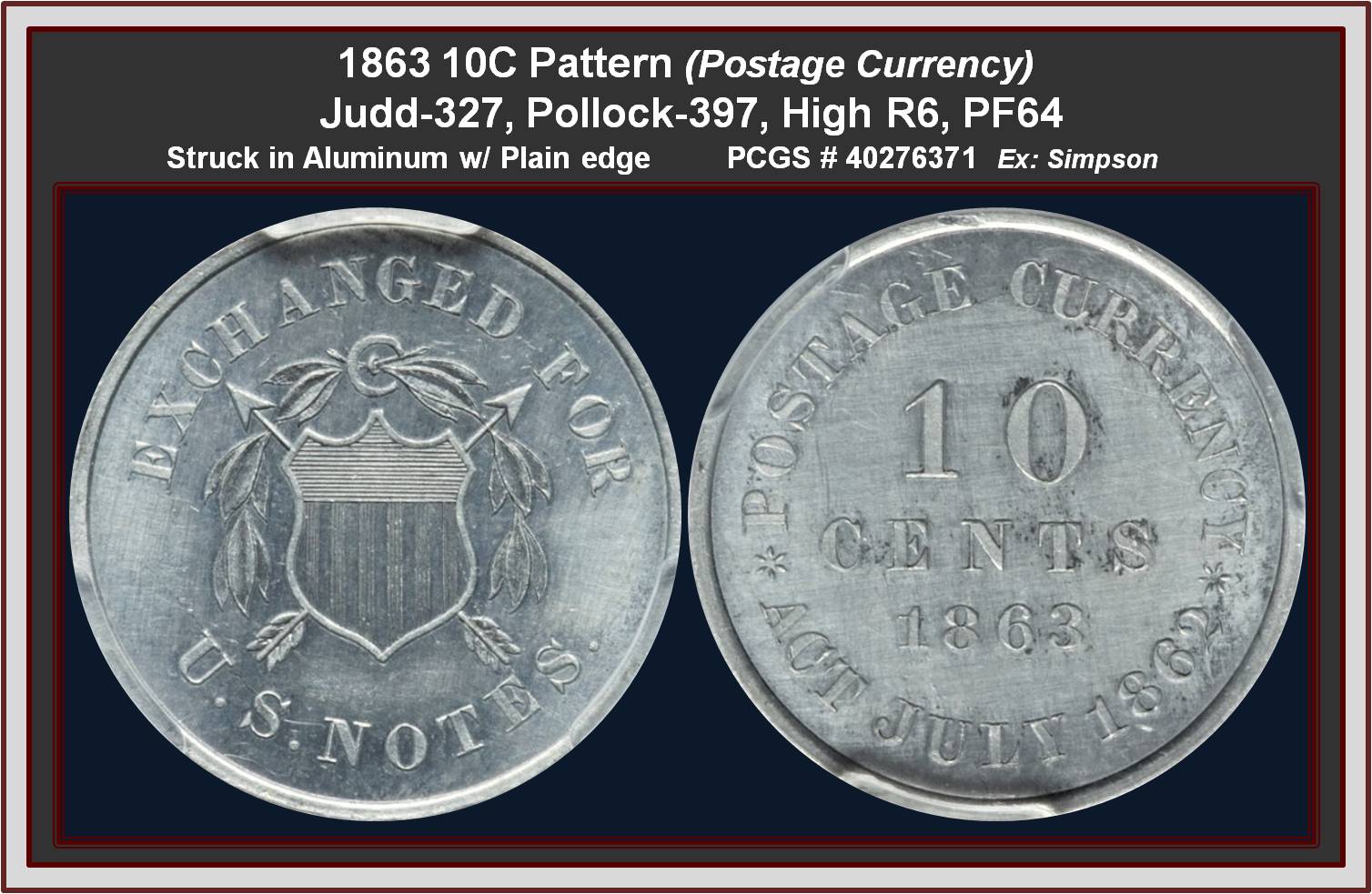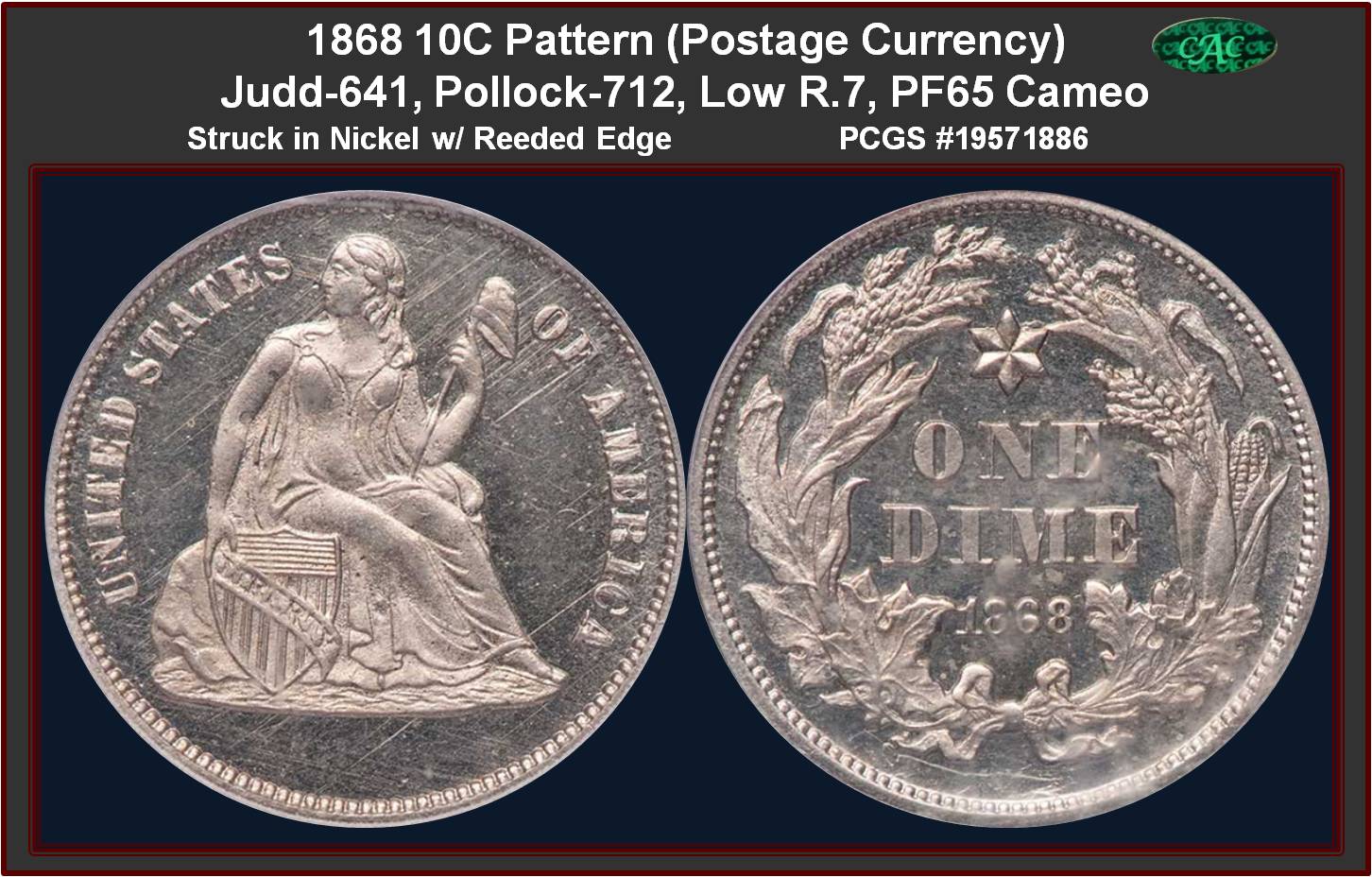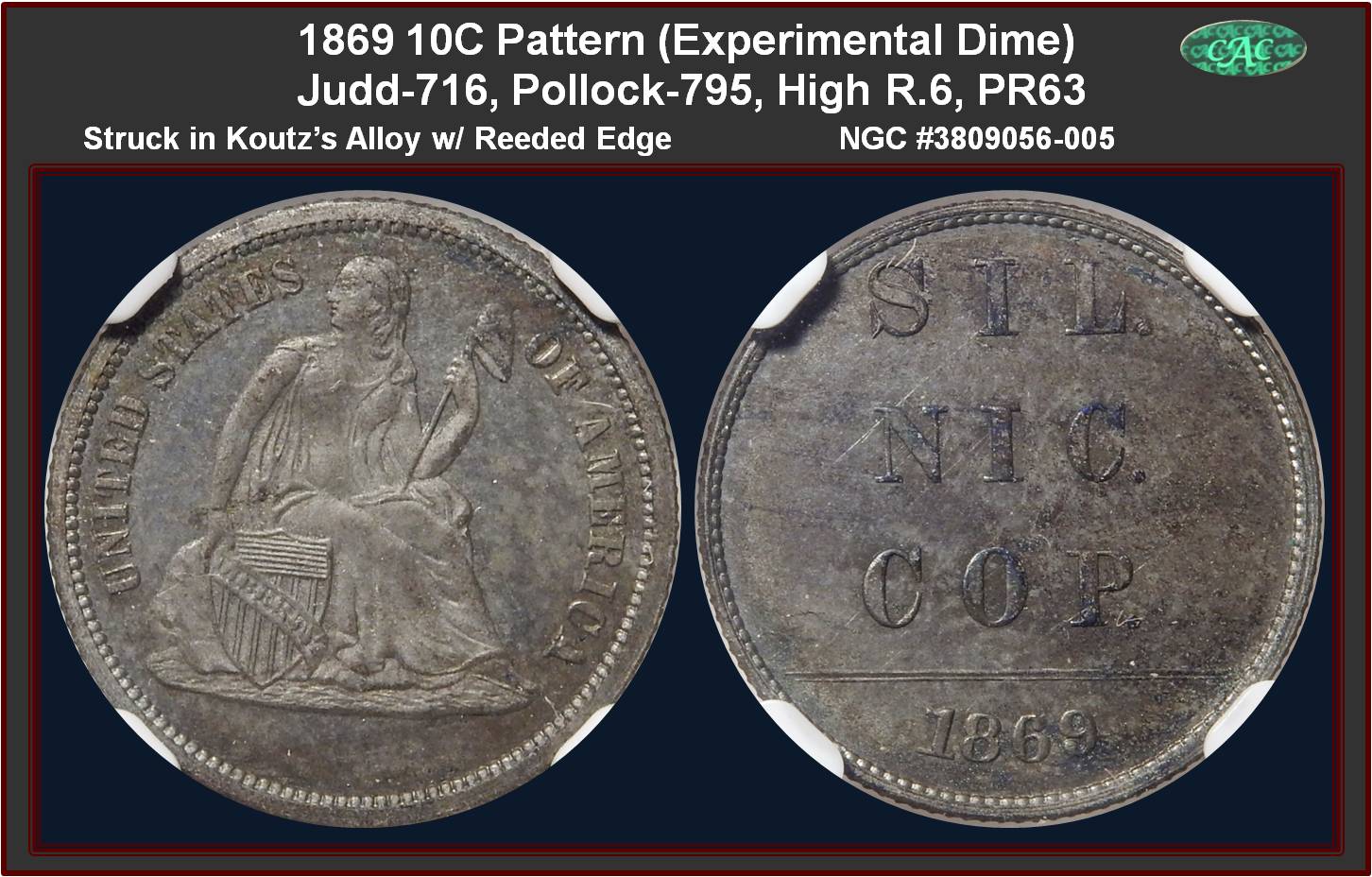
Set Description
POSTAGE COINAGE
In 1863 10 cent pieces ( call Tokens then) were struck with a unique inscriptions "EXCHANGE FOR US NOTES" on the obverse and the reverse stated "POSTAGE CURRENCY" "ACT OF JULY 1862".
The concept behind these experimental dimes were smaller and light weight they may not be suspected to hoarding as their regular minted dime counterparts had been and that they be use in exchange small denomination postal currency notes still widely used. The design is of interest as the date are on the reverse of the coins, and that the 2 obverse dies and 2 reverse dies were mix and match to create the 4 different patterns.
the few pieces dated 1868 are believed to have been struck in 1863 as well.
Per USpattern.com web site, the research by David Cassel ( Author of "UNITED STATES PATTERN POSTAGE CURRENCY" 2007) has found that many of the descriptions by weight, edge characteristics, and alloys listed in Judd and Pollock reference are inaccurate to say the least.
This set samples the various designs.
(Click on image to enlarge)

Mint experiment with seeking new alloys for coinage and to seek nickel substitutes. Attempts to combine silver and copper with nickel proved difficult to point that they showed Silver and Nickel were incompatible.
This set show a couple of sample patterns with a composition engraved.
(Click on image to enlarge)

Click here Return to Mania's Master Pattern Listing
Mania's US Patterns- WHAT U.S. COINAGE COULD HAVE BEEN
=========================================================
Set Goals
Simple - collect the 4 different combination of these postage current Dime/TEN CENTS. Collect additional off metal types as available of the J-325 - 330 designs.
| | | | | | |
| | | | | | |
|
View Coin
| Shield Obverse |
United States
|
10C 1863 J-325 SAMUEL BERNGARD COLL.
|
NGC PF 63
|

1863 Dime Postage Currency
Judd-325, Pollock-390
Rarity Low R,6 PF63 CAC Endorsed
Struck in silver with plain edge
Obverse: Exhibits an ornamental shield with an inverted laurel wreath suspended from a ring. A pair of crossed arrows are behind the shield, and the inscription EXCHANGED FOR / U.S. NOTES is around the periphery
Reverse:, The denomination 10 CENTS and the date 1863 are surrounded by the inscriptions POSTAGE CURRENCY and ACT JULY 1862.
Comment:
Bright and reflective in the fields, while the lettering and devices show light frost to provide contrast. The strike is sharp and the surfaces are pleasing, with minimal signs of handling. Both dies show cracks and stress.
This piece appears identical and thus believed to be those auction by Heritage in 2000 and 2003 as PCGS PF64 #3504478 ( now deactivated ). At that time is labeled as 19.9 grains. A SEM-EDX analysis (#3504478) was performed, indicating this piece's composition is 96.1% silver and 3.9% copper but even back in 2000 it was deemed lost.
Issued to redeem U.S. notes then in circulation, at least this was the plan at the time these were proposed.
James B. Longacre designed this pattern in May, 1863. At that time, three weight variants were struck of the plain edge silver Postage Currency patterns. No silver pieces of this design are known to have a reeded edge. A combined total of 43 coins at 20 grains and the 22.5 grains were struck to demonstrate the physical properties of two versions of a very thin ten cent silver coin. One plain edge, nearly pure silver fantasy piece was struck weighing 38.3 grains. The authorized weight of a standard silver ten cent coin was 38.4 grains. The intrinsic value of the 20 grain coin offered here in 1863 was given by Mint Assayer William E. DuBois at 5.21 cents or 5.5/24ths cent. The value of the 22.5 grain coin was given by DuBois at 5.73 cents or 5.35/48ths cent. The coins were so thin that DuBois later commented to Salmon P. Chase that they could not be struck using the Mint's steam presses because the thin planchets would jam the machine. These pieces were struck using a screw press. Two coins are known whose planchets were cracked while being struck. It is presumed they were the victims of the steam press. This is only one of several drawbacks to the authorization of these token coins for the purpose of replacing various temporary monetary expedients, much less, the nation's subsidiary coinage
Provenance/Appearances:
From Samuel J. Berngard Collection Stacks and Bowers Mar 2012 Baltimore / Lot #7121; Priors
Heritage Jan 2000 F.U.N. / Lot #7418 and Heritage Jul 2003 Baltimore / Lot #9956 ($2300) both as a PCGS PF64
It was noted in those auctions that this piece was purchased by Mr. Wolfe from Kreisberg and Cohen's Quality Sales Auction, June 29, 1970, lot 1284. Mr. Wolfe had calculated the coin's specific gravity at 10.45.
|

|
|
View Coin
| Shield Obverse
In Aluminum |
United States
|
10C 1863 J-327
|
PCGS PF 64
|

1863 10C Ten Cents,
Judd-327, Pollock-397
Rarity: High R.6, PR64
Ex: Simpson.
Struck in aluminum with a plain edge
Obverse: The obverse depicts a Union shield pierced by two arrows; a simple wreath rests above. The remainder of the design consists of token-like legends; EXCHANGED FOR U.S. NOTES
Reverse:
In the center “10 CENTS” and the Date “1863” with “POSTAL CURRENCY” wraps at top and “ACT JULY 1862” wraps at the bottom border.
Comment:
Seated coinage was silver and widely hoarded. Judd-327 was a proposal to fill the void, though fractional currency was eventually issued instead. This is a well struck piece with lightly marked surfaces exhibit medium steel-gray toning with glimpses of charcoal patina.
During the Postage Currency experiment, samples were prepared utilizing various compositions. Mint Director Pollock sent various samples to Secretary of the Treasury Salmon P. Chase, with a description of each. Regarding the aluminum samples, Pollock noted “In aluminum, one weighs eight grains: about as thin as would be practicable: intrinsic value about five cents; nominal value ten cents.” An interesting side note to this report is the value of aluminum in 1863, about $3.00 per troy ounce.
This aluminum striking is especially important from a numismatic viewpoint.
Provenance/Appearance:
From the Bob Simpson Collection Heritage Jan 2021 FUN Signature Auction / Lot #3099; Prior
- Heritage Jan 2007 (FUN) / Lot #1288 (passed) NGC 64 (Passed)
- American Numismatic Rarities 1/3/2006 sale of the Prescott Collection / Lot #884 (NGC64) (Passed)
- Heritage May 2005 (CNSN) / Lot #8305 (passed) NGC 64 (Passed)
|

|
|
View Coin
| Liberty Seated |
United States
|
10C 1863 J-331
|
PCGS PF 64
|

1863 10C Ten Cents
Judd-331, Pollock-402
Rarity: High R.7, PR64 CAC Endorsed
Ex: Simpson.
Struck in copper-nickel with a reeded edge.
Obverse: The design is a dateless Seated Liberty obverse
Reverse: The proposed postage currency reverse featuring 10 CENTS 1863 in the center and * POSTAGE CURRENCY *ACT JULY 1862 around the margin.
Comment: There are five confirmed examples of Judd-331 (formerly Judd-331B), per USPatterns.com. They were produced in 1869 from leftover 1863 dies that were lapped to move rust.
Pale golden-gray surfaces are moderately flashy and partly reflective. Well-struck with an area of reddish color over the left side of Liberty's profile.
The view of these pieces was to be used to redeem small denomination postal notes. It was thought that silver coins of standard .900 fineness, but of reduced weight, would circulate without being subject to hoarding as were the regular-issue full-weight coins.
Provenance/Appearance:
Ex Bob Simpson Collection part 2 Heritage Nov 2020 / Lot #3129; Prior
- Superior Jan 2003 Elite Coin Auction /Lot 512;
- Ira & Larry Goldberg Auctioneers MAY 2001 The Fairchild Family Trust Collection /Lot 1084 In this auction the catalog made a notation “With a small white envelope with the price $90. from many years ago”
|

|
|
View Coin
| Liberty Seated |
United States
|
10C 1868 J-641
|
PCGS PF 65 Cameo
|

1868 10C Postage Currency,
Judd-641, Pollock-713
Rarity: Low R.7, PR65 Cam CAC Endorsed
Struck in Nickel with Plain Edge
Obverse: The obverse is the regular issue design of the Seated Liberty dime except with no date.
Reverse: A six-pointed star, the denomination ONE DIME and the date 1868 are enclosed by a wreath of cereals.
Comment:
Numismatic researcher David Cassel has researched this and other related issues, all included under the broad category as "postage currency." His research shows that this pattern issue was actually coined in 1863 from a die that was incorrectly dated 1868.
Sharply struck devices have a bold frosty look that contrast brilliantly against the clean, deep, awesome mirrors. A few minor ticks in the planchet are noted and do not detract from the eye appeal. VERY RARE and while the design is only lightly different than the regular issue, the differences make this pattern issue unique and more elegant
Provenance Appearance:- FROM THE STEVEN COOK COLLECTION Legends Auction #26 May 17, 2018 / Lot 718; Prior
- Stacks September 2011 Philadelphia Americana / Lot 5777;
- Heritage March 2011 Sacramento ANA / Lot #4387 (PCGS# 4693181);
- Stacks 3/3/2010 Selections from the Estate of Louis E. Eliasberg, Jr. and the Collection of Chester L. Krause / Lot 1304 (PCGS PF65);
- Heritage Feb 2009 Long Beach, CA Signature Auction / Lot #2326 (PCGS# 4693181);
- Also the Superior June 1998 Auction /Lot #1991 (also PCGS holder #4693181)
- Heritage Jul 1997 ANA Lot #7294
|

|
|
View Coin
| Shield Obverse |
United States
|
10C 1868 J-644
|
PCGS PF 64
|

1868 10C Postage Currency
Judd-644, Pollock-716, Cassel-18
Rarity: Low R.7, PR64 CAC Endorsed.
Ex: Garrett.
Struck in copper-nickel with a reeded edge
Obverse: A central shield with diagonal arrows behind, EXCHANGED FOR above and U.S. NOTES below.
Reverse: A variant of the adopted design with the central wreath surrounding ONE DIME, a six-pointed star above and the date below.
Comment:
This series of patterns have less advanced die cracks than their 1863 counterparts. Occasional striking softness and areas of die rust and die cracks can be seen with a loupe. Pale rose toning covers otherwise brilliant surfaces.
The metallic composition of this piece is listed as 75% copper and 25% nickel.
30.70 grains
Provenance/Appearances:
From Heritage Jan 2020 FUN - Orlando / Lot #5874; Prior Ex: John Work Garrett Collection (Stack's, 3/1976)/lot 602; Paramount's session, Aug 1982 Auction '82 / lot 1814; Charmont Sale (Steve Ivy, 8/1983)/lot #4586; Milton R. Friedberg Collection (C.A.A., 1/1997), lot 1128; David Cassel Collection / ANA Signature (Heritage, 8/2015), lot 595.
|

|
|
View Coin
| Seated Obverse
Sil/Nic |
United States
|
10C 1869 J-715 100% Cu (2.4 g)
|
NGC PF 66 BN
|

1869 10C Postage Currency
Judd-715, Pollock-794
Rarity: Low R.7 PF66BN
Ex: David Cassel
Struck in Copper with Reeded Edge
Obverse: The obverse is similar to the regular issue, but without the date in exergue.
Reverse: The reverse has SIL. 9/ NIC. 1 in larger letters, the date is below, smaller, and slightly curved.
Comment:
Of the six known examples of this copper striking, this is the finest certified. SEM-EDX testing by Ledoux & Company Certificate number 919577-011 proved it to be almost pure copper: 99.7% copper and 0.2% nickel. Curiously, the silver / nickel alloy stamped on the reverse of this piece does not appear to exist on any coins of this design.
Lilac-red, sea-green, and orange-gold toning enriches both sides. Parallel diagonal roller marks cross the obverse, but post-strike imperfections are limited to minor carbon.
Provenance/Appearance:
From The Towers Collection, Heritage CSNS May 2024 Lot #3703 Ex:
- Long Beach Bullet Sale (Heritage, 9/28/1998), lot 1021;
- Pre-Long Beach (Goldberg Auctions, 5/2003), lot 596;
- David Cassel Collection / Chicago ANA Signature (Heritage, 8/2015), lot 5959;
- Central States Signature (Heritage, 4/2016), lot 1234.
|

|
|
View Coin
| Seated Obverse
Sil / Nic/ Cop reveree |
United States
|
10C 1869 J-716
|
NGC PF 63
|

1869 10C Postage Currency
Judd-716, Pollock-795
Rarity: high R.6, CAC Endorsed
Struck in Koulz's Alloy (1)
Obverse: The obverse is similar to the regular issue, but without the date in exergue.
Reverse: The reverse has SIL. / NIC. / COP. in larger letters, the date is below, smaller, and slightly curved.
Comment: This second reverse pattern has a reeded edge and was struck in a supposedly unworkable alloy of silver, nickel, and copper: Koulz's alloy. Because of the brittleness of the alloy, examples are invariably seen with chipping and flaking. Here the brittleness is mostly seen at the bottom of the obverse and top of the reverse. Each side is deeply toned.
Provenance/Appearance:
From The Virginia Cabinet, Heritage April 2015 CSNS Chicago/Lot #5984
(1) an article on US Patterns.com -- "A Misnomer Mystery Finally Solved" Copyright By David Cassel , Author of “United States Pattern Postage Currency Coins” reports that Koulz's may have been a simple typographical error and was not the correct name but rather Montchal Ruolz proposed the metal (who was born in Paris in 1809).
|

|
  
 | Loading… |
|
|